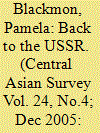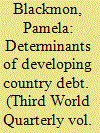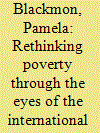| Srl | Item |
| 1 |
ID:
178469


|
|
|
|
|
| Summary/Abstract |
Uzbekistan and Kazakhstan have new leaders for the first time since 1989: Shavkat Mirziyoyev as Uzbek president and Kassym-Jomart Tokayev as Kazakh president. This article uses a theoretical framework based on the literatures of leadership change and political succession while overlaying this literature with the type of economic policies followed by each former leader to analyse the political and economic transitions in these countries. Mirziyoyev has legitimized his authority, even though he was not part of the elite, through reforms designed to help the people (as Karimov had envisioned in the ‘Uzbek way’). In contrast, Nazarbayev’s policies were centred around the state as a facilitator of economic development, a problem for citizens in an economic downturn. While Tokayev transitioned through a formal electoral process, his was a ‘managed’ designation, with the charismatic leader still in a formal position of power, leaving Tokayev without a separate base of legitimacy.
|
|
|
|
|
|
|
|
|
|
|
|
|
|
|
|
| 2 |
ID:
067356


|
|
|
| 3 |
ID:
134401


|
|
|
|
|
| Summary/Abstract |
Programmes designed to alleviate developing country debt have been implemented by bilateral, commercial and multilateral creditors and sovereign debt has been restructured under Paris Club negotiations. These strategies have not been very successful at reducing the debt levels of developing countries, in part because they continue to receive export credit insurance facilities through export credit agencies (ecas). The purpose of this paper is to examine the high percentages of developing country debt owed to governmental ecas. Analysis of the external debt of low-income and lower middle-income economies at five year intervals from 1980 to 2010 finds a substantial part of the indebtedness of these economies is held by ecas. Analysis of specific sub-Saharan African countries undergoing debt rescheduling and forgiveness through Paris Club negotiations was done for Ghana and Kenya. These results show that, following debt restructuring, new export credit guarantees and/or loans were forthcoming to these countries from the ecas of the creditor countries that rescheduled their old debt in Paris Club negotiations during 2000–12.
|
|
|
|
|
|
|
|
|
|
|
|
|
|
|
|
| 4 |
ID:
080414


|
|
|
|
|
| Publication |
2007.
|
| Summary/Abstract |
This article compares two transition economies that have diverged in their progress on important economic reform areas and then seeks to link these differences to their resulting levels of investment and business. For this study, interviews were conducted with firm representatives that had invested or conducted business in Kazakhstan and Uzbekistan in order to determine the areas of reform that were the most important for their investment and business decisions. The analysis indicates a relationship between Kazakhstan's advanced economic reforms in such areas as foreign investment legislation, tax legislation, banking system reform, and higher levels of investment and business. Uzbekistan's lack of progress in these reform areas has affected the level of investment in the country, but not the number of firms conducting business. This was primarily because firms could secure financing for the business through the US Export-Import Bank
|
|
|
|
|
|
|
|
|
|
|
|
|
|
|
|
| 5 |
ID:
082458


|
|
|
|
|
| Publication |
2008.
|
| Summary/Abstract |
This essay investigates factors that caused shifts in the policies of the International Monetary Fund (IMF) and the World Bank which culminated in new frameworks for poverty alleviating initiatives. The introduction of the Heavily Indebted Poor Countries Initiative (HIPC) in 1996 as well as the subsequent broadening and expanding of this program into the Enhanced HIPC Initiative coupled with the implementation of the Poverty Reduction Strategy Papers in 1999, were some of the strongest initiatives to date by the institutions to address poverty in the poorest countries. Institutional characteristics of the IMF and the World Bank are found to be an important explanatory factor for their differing approaches to alleviating and understanding poverty. The World Bank has evolved to be able to address poverty as a societal and developmental issue, as a result of the formation of programs to include input from the poor themselves. The IMF has been slower in this evolutionary process and is still more likely to focus on macroeconomic issues that affect the poor such as high inflation and slower economic growth
|
|
|
|
|
|
|
|
|
|
|
|
|
|
|
|